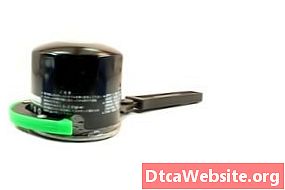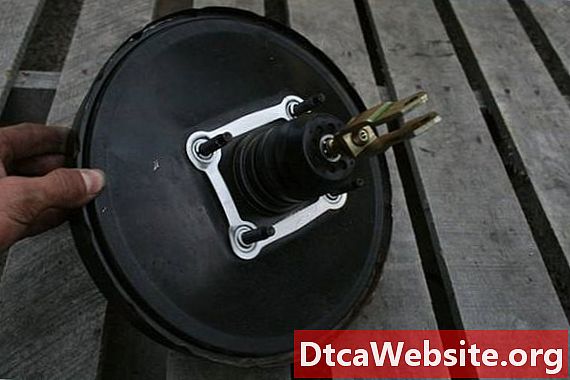
Contenu

"Cracked engine block." The very words a shudder through the hearts of gearheads and Average Joes alike — and for good reason. In the common mind, cracked blocks and cylinder heads are one of those deal-breakers where an engine transitions from hypothetically repairable to effective paper-weight. Welding cast iron is difficult or impossible in many cases, especially when considering the damage wrought by rapid heat expansion and cooling. Cold metal-stitching isnt something the average mechanic can or will do at home — its something of an art that requires numerous specialized tools and skills — but knowing whats involved may at least help you sleep better when you get the bill back from your machine shop.
Step 1
Identify the crack with your three-part penetrating dye system. First, spray or paint your penetrating dye over the suspected crack and the surrounding area, then wait 5 minutes. Spray the dye-cleaner on a lint-free cloth and clean all of the dye off of the surface of the block. Once you have all visible traces of dye off, spray a light or "dry" coat of developer over the area, then use compressed air to accelerate the drying. Wait at least 1 minute; the crack will be clearly visible in bright purple, red or blue.
Step 2
Identify the three types of stitching pins in your kit. The standard L-series pin is a straight-threaded pin that looks like a machine screw with the shaft slightly tapered outward toward the head. Near the head, youll see a groove that allows the screw-head to break off. This type of pin exerts a spreading pressure on the crack to seal it. The second type is longer, has a flat tip, uses spiral-hook threads and uses a non-tapered head; it exerts a radial clamping force and is used for structural integrity and sealing.
Step 3
Drill a hole through the block (size recommended by the pin manufacturer) just before the crack starts. Place the drill jig so that its locating pin sits in the first hole, then drill down through the jig guides two holes to create a line of three holes. Move the jig so that the locating pin sits in the last hole and repeat. Continue until you have a line of holes running through the entire length of the crack.
Step 4
Spotface or "countersink" the holes using the spotfacer. This is the most important step in the whole process. Set the spotfacers depth guide so that 1/8- to 3/16-inch of material is left in the casting for the pin threads to grab onto. Countersinking too deep will not leave enough material for the pin to grab, and countersinking too shallow will fail to seal the block. Once youve set the depth guide, lubricate the pin hole with plenty of tapping fluid, and use the spotfacer to create the holes into which the pin "shoulders" will fit.
Step 5
Tap the holes using the kit-supplied power-tapper or your own tap sized to fit the manufacturers recommendations. Keep the tap lubricated with either tapping fluid or tapping wax. Remember to use a back-and-forth tapping technique; turn the tap 1/4 turn, back it off to remove the material, turn it 1/2 turn, back it off 1/2 turn to remove the material, turn a full turn (cutting another 1/2-turns worth of thread), back it off 1/2 turn and repeat until the hole is fully tapped.
Step 6
Drive the L-series pins into the holes, continuing to turn them until the bolt head snaps off. If youre sealing a portion of the block that intersects a water jacket, then use the manufacturer-recommended thread sealant on the pin threads before you install them. Keep going until youve installed pins in all of the holes. Once youve got pins installed in all of the holes, youve got the first row completed.
Step 7
Drill a single hole just to the right of the left-most pin so that the hole starts just at the edge of that pins shoulder. Use the drill jig to drill another series of holes; all should land on the right-hand edge of another pins shoulder. Spotface and tap those holes. The spotfacers cutting head will actually cut into the adjacent pins shoulder. Install the pins with thread sealant and continue until youve filled all the second-series holes.
Step 8
Drill, spotface, tap and pin a third series of holes in the remaining gaps between the installed pins. At this point, youll have removed all of the original cast iron and youll be spotfacing into the pins on both the left and right sides. Once youve finished this third series of pins, youll have created a fully contiguous "weld" running the length of the crack where the sides and heads of each pin overlap the next.
Step 9
Grind the pin shoulders almost level with the block (leaving a small ridge for needle scaling) and examine the stitch for gaps. You can do this either visually or by applying more penetrating dye. If you find any gaps, drill, spotface, tap and fill them with another pin. Dont be afraid to use the pins as "fillers" between other pins; the pin material is stronger than your original black, and it can take some drilling into.
Step 10
Pressure-test the block with compressed air and soapy water, watching for bubbles in the crack. If you see any, then — you guessed it — install a pin in the hole. Once the block is leak-free, use a pneumatic or electric needle scaler (which looks like a bunch of metal ball-point pens all bundled together) to flatten the pin heads, sealing them completely and leaving a factory-looking finish.
Paint the repair with a sealing epoxy (JB Weld also works well for this task), sand it flat and then paint the block with a high-temp engine epoxy or enamel. Your new stitch-weld will have similar expansion characteristics to the cast iron and should ultimately outlast the cast engine block around it.
Warning
- Do not try to weld engine block cracks!
Items you will need
- Basic hand tools
- Compressed air supply
- Basic compressed-air tools
- Metal-stitching kit with pins
- Needle scaler
- Epoxy sealer
- Engine paint, epoxy or enamel


